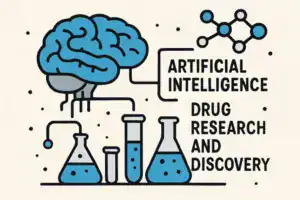Key Takeaways
- AI accelerates the drug discovery process by analyzing vast datasets to identify potential drug candidates.
- Machine learning models predict molecular interactions, reducing the need for extensive laboratory testing.
- AI-driven platforms are making drug development more accessible and affordable.
Table of Contents
- Introduction
- Accelerating Drug Discovery
- Enhancing Predictive Accuracy
- Reducing Costs and Time
- Improving Clinical Trials
- Personalized Medicine
- Challenges and Future Prospects
- Conclusion
Introduction
Artificial intelligence (AI) fundamentally reshapes the pharmaceutical industry, providing unprecedented advantages for drug discovery platforms. By leveraging advanced computational models and vast datasets, AI is automating and optimizing many of the once time-consuming and labor-intensive steps in drug development. Traditionally, a drug’s journey—from early target identification to regulatory approval—could take over a decade, with significant risk and expense at every stage. Thanks to AI-driven approaches, the tide is turning: pharmaceutical researchers now benefit from sophisticated tools that can quickly sift through enormous volumes of data, uncover novel drug targets, and predict outcomes with far greater accuracy than ever. These advancements enable quicker turnaround for new medications, drive down research costs, diminish trial-and-error inefficiencies, and create new opportunities for groundbreaking therapies. As highlighted by the AI drug discovery platform, this new technology is already propelling some of the most significant breakthroughs in modern medicine, revolutionizing how treatments are discovered, developed, and deployed.
Innovations in AI-driven solutions—including machine learning, predictive analytics, and natural language processing—are fundamentally streamlining the process of identifying, testing, and developing new treatments. Today’s advanced platforms can parse, learn from, and act upon complex biological data at a speed and scale unimaginable even a few years ago. By automatically identifying intricate patterns and correlations within scientific literature, genetic sequences, experimental data, and clinical trial outcomes, these tools are making it possible to uncover hidden biological insights that would remain undetected using traditional methods. As a result, researchers can pursue highly targeted drug candidates, optimize molecule design right from the outset, and rapidly prioritize leads for further investigation. The pharmaceutical landscape is thus shifting toward more agile, responsive, and productive research and development frameworks, setting the stage for a new era of medical discovery.
Accelerating Drug Discovery
Traditional drug discovery has long been beset by lengthy timelines, high attrition rates, and enormous expenses, but AI solutions promise to upend this status quo. By employing state-of-the-art algorithms, pharmaceutical scientists can swiftly analyze enormous datasets containing information about chemical compounds, protein structures, disease pathways, and biological interactions. This computational prowess enables the discovery and prioritization of promising drug candidates in a fraction of the time it historically required. For example, recent advancements delivered by companies such as Insilico Medicine have allowed the development of a fibrosis treatment candidate to move from initial concept to preclinical study in just 18 months—a process that would typically span several years or more. By integrating massive, disparate data sources, AI can identify connections between diseases and compounds that may have gone unnoticed by human researchers. This remarkable reduction in time highlights the transformative potential of AI-powered platforms in expediting the entry of new drugs into the research pipeline and, ultimately, bringing innovative therapies to market more quickly than ever.
Enhancing Predictive Accuracy
Integrating machine learning within AI frameworks has dramatically improved drug discovery platforms’ predictive accuracy. Rather than relying solely on costly and time-consuming physical trials, AI models can now simulate and predict how thousands—if not millions—of different molecules might interact with specific biological targets. This virtual screening process allows for a robust analysis and rapid narrowing of the most promising candidates, eliminating unpromising options well before any experimental resources are committed. These sophisticated systems help researchers avoid the pitfalls of trial-and-error approaches, dramatically lowering the risks and resource drain traditionally associated with drug development. AI not only analyzes chemical properties but also can incorporate real-world clinical data, genomics, and patient outcomes to predict which drugs are most likely to succeed. This data-driven intelligence ensures a sharper focus during experimental validation, increasing the chances of success at every subsequent research stage and providing an enormous competitive edge.
Reducing Costs and Time
Bringing a new pharmaceutical product to market has always entailed a formidable commitment of time and money, with average costs often exceeding $2.5 billion and development timelines stretching more than 10 years. AI stands poised to reduce both of these barriers dramatically. Automated data analysis, more precise drug design, and predictive models help shave years off development cycles and save millions—or even billions—in research-related expenses. AI not only assists in the identification of viable leads but also optimizes preclinical testing, allowing for the more efficient selection of compounds with the highest probability of success in humans. This efficiency is more than just a theoretical promise: real-world examples show that AI-enabled platforms can accelerate early-stage discovery, streamline toxicology screening, and reduce redundant experimentation. Adopting computational modeling in early-stage development shifts significant portions of discovery “in silico,” helping companies re-allocate their financial and human resources to the highest yield projects.

Improving Clinical Trials
Clinical trials are a crucial yet notoriously challenging phase of drug development, with success rates hovering at just 10–15% for many therapies. AI is helping to transform this landscape in several pivotal ways. First, AI tools can analyze real-world healthcare data, genomic datasets, and electronic medical records to facilitate optimal patient selection, ensuring that trials are more likely to enroll participants who will benefit most from a given investigational therapy. Advanced models provide insights to fine-tune trial design, optimize protocol adherence, and even predict the likelihood of adverse drug effects, proactively enhancing patient safety. AI-powered monitoring technologies can analyze patient data in real-time, flagging potential safety concerns and improving the quality of trial data. These enhancements collectively increase the chances of clinical success, helping new drugs gain regulatory approval faster while reducing the risk of expensive trial failures. By making clinical trials more efficient, accurate, and patient-centered, AI ultimately helps deliver life-saving medications to patients with greater speed and reliability.
Personalized Medicine
Personalization is quickly becoming the gold standard in medicine, and AI is at the forefront of this paradigm shift. AI platforms have the ability to analyze enormous volumes of individualized patient data—ranging from genetic makeup to lifestyle information and medical records—enabling the design of therapies tailored precisely to the biology of each patient. This approach increases the efficacy and safety of treatments, as each intervention is custom-fit to the patient’s genetic profile and clinical context, reducing adverse effects and improving overall outcomes. Beyond treatment, AI-driven insights also empower the development of proactive interventions and preventive strategies, helping physicians anticipate disease risks and intervene before symptoms even arise. As AI becomes more deeply integrated within healthcare infrastructure, models will support more sophisticated forms of population health management and chronic disease prevention, ultimately delivering on the promise of medicine that is both highly targeted and profoundly individualized. The continuous merging of AI and biomedicine is expected to catalyze the next wave of breakthroughs in patient care.
Challenges and Future Prospects
Despite the rapid growth and many advantages of AI-driven drug discovery, certain formidable challenges remain. Access to high-quality, comprehensive datasets remains essential for robust machine learning and predictive modeling, yet the fragmentation of healthcare data, data silos, and inconsistent standards continue to impede progress. The need for robust regulatory frameworks is becoming more urgent as AI models are relied upon for high-stakes clinical decision-making, and ethical considerations around data privacy, bias, and transparency must be carefully managed. Translating algorithmic predictions into solutions that are clinically meaningful and evidence-based represents another layer of complexity, calling for ongoing collaboration between computational scientists, clinicians, regulators, and industry leaders.
Nevertheless, the field continues to evolve at breathtaking speed. Continuous advancements in AI technology, greater cross-disciplinary collaboration, and evolving international regulations are paving the way for a new era in pharmaceutical innovation. As more drug developers and healthcare providers embrace platforms like the AI drug discovery platform, the industry is shifting toward more sophisticated, cost-effective, and patient-centric discovery models. Ongoing integration of AI holds the promise of accelerating the delivery of innovative therapies that address unmet medical needs and improve patient outcomes worldwide, marking a bright future for both providers and patients.




